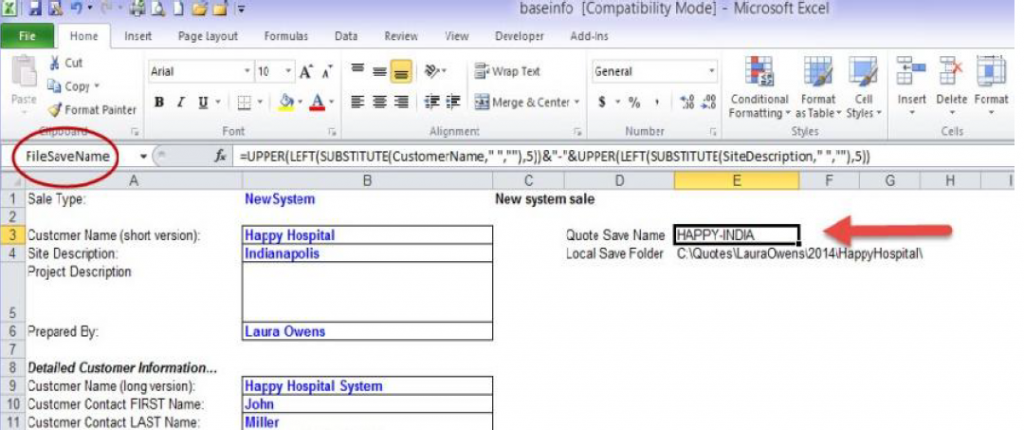How to Setup Auto-Naming and Auto-Saving in your Quote Files
Auto-Saving and Auto-Naming your Quote Files
You might encounter this when you want to set up an intuitive naming scheme for your quotes and folders where SDA quotes are saved. Resources needed to make this work:
- SDA Architect Manager (AM)
- Shared network drive if saving to a network resource
- Definitions AutoName: Use the information in the quote file to create a unique file name that SDA will save the quote to.
- Auto Save: Define a location (on the local drive or on a shared network drive) that quote files created with SDA will be saved to. You can define both a local and a network location – SDA will try first to save to the network location and if unavailable will next save to the local location.
A Sample Scenario
Your user is working on a quote for the Happy Hospital System, which has multiple site locations (multi-site quote). You’d like to store all of the site quotes for this client in one folder and each quote should be named so you can easily see which quote is for which site.
Auto File-Naming Steps
- Open the raw Base Info tab, which is located in the C:\CorsPro\PQuote\Data folder on most implementations.
- Select a blank cell somewhere on the sheet and create a named range called FileSaveName for that cell (you can name the cell by clicking on it, then clicking the Name Box to the left of the formula bar, then entering “FileSaveName” as the name for the cell). You will be populating this with an Excel formula that will calculate a file name for your quote files based on the data in each quote.
Here’s an example of an Excel formula you can use to create the auto save filename.
- First click into the named range cell and then enter the following formula. It will create a file name for this quote based on what you enter in the quote’s Customer Name and the Site Description cells.
=UPPER(LEFT(SUBSTITUTE(CustomerName,” “,””),5))&”“&UPPER(LEFT(SUBSTITUTE(SiteDescription,” “,””),5))
We suggest using the SUBSTITUTE Excel function to remove any spaces in a file or folder name to avoid confusion. The above example will put the first leftmost 5 characters of a customer name as entered in the quote, a dash, then the first leftmost 5 characters of the site description to create a unique file name for quotes. The “UPPER” part of the formula will then capitalize the entire file name.
It is also helpful to click into the cell next to your named range and add a label for that cell, something like “Quote Save Name” or something descriptive.

- There are several options you can add in the same manner (by defining a named range and populating it with an Excel formula) to make your file name even more descriptive – quote versioning, workflow rules, etc. Be sure to check the Architect Manager user manual for further details on those additional options. Search for “Auto-save” to find the information.
- Save your Base Info tab. When you start a new quote, the new Base Info tab will be brought in automatically. For an existing quote, you can update it to the new version by clicking Update Tab(s), then “Replace tab with new version using current user inputs”.
Auto File Saving Steps
It’s the same process to define a save path to a location you’ve chosen to store your quotes– SDA will calculate the folder path for you using Excel formulas and data from your current quote. If the folder doesn’t exist yet, it will be auto-created.
- Define a save path in cell(s) named as NetworkSaveFolder and/or LocalSaveFolder. If you define both of these named ranges, SDA will attempt to save a quote file to the NetworkSaveFolder location first and then to the LocalSaveFolder.
- For example, let’s say you want to save all quote files to a local directory. To set this up, click into a cell on the Base Info tab and define LocalSaveFolder as the name for that cell. In that cell, type in the formula that will calculate the location where you want the file to be saved. In this example, your quotes will be stored in a folder defined by the data in your quote, and we again use the SUBSTITUTE function within Excel to remove unnecessary spaces.
=SUBSTITUTE(“C:\Quotes\”&PreparedBy&”\”&YEAR(NOW())&”\”&CustomerNam e&”\”,” “,””)
- Be sure that your users populate Prepared By and Customer Name in their quotes so that the correct folder path gets calculated. You might want to create a FileSaveStatus named range and create a formula that prevents files from being saved unless the user enters the information that’s required to calculate the save folder path (search for “FileSaveStatus” in the Architect Manager user guide for more information).
- Click into the cell next to your named range and add a label for that cell, such as “Local Save Folder” or something descriptive.

Don’t forget that when you make changes to your Base Info tab you will need to create and push updates out to your users so they get the new version of the tab. All new quotes they create after updating will have the new version of the Base Info tab, and if they open any existing quote files they will need to do a Add-Ins > Update Tabs > Update all tabs using current inputs to update the Base Info tab to the newer version. Using the Auto-Saving functionality within.
SalesDoc Architect saves you and your users time, ensures consistency and makes it easy to find the files you need. Investing the time to enable these features is well worth it!
Go Back to Tip Sheets for Common Issues Main Page